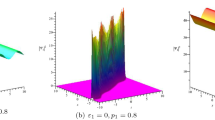Abstract
For the Davydov Hamiltonian several special cases are known which can be solved analytically. Starting from these cases we show that the initial state for a simulation using Davydov′s |D1> approximation has to be constructed from a given set of initial lattice displacements and momenta in form of a coherent state with its amplitudes independent of the lattices site, corresponding to Davydov′s |D2> approximation. In the |D1> ansatz the coherent state amplitudes are site dependent. The site dependences evolve from this initial state exclusively via the equations of motion. Starting the |D1> simulation from an ansatz with site dependent coherent state amplitudes leads to an evolution which is different from the analytical solutions for the special cases. Further we show that simple construction of such initial states from the expressions for displacements and momenta as functions of the amplitudes leads to results which are inconsistent with the expressions for the lattice energy. The site-dependence of coherent state amplitudes can only evolve through the exciton-phonon interactions and cannot be introduced already in the initial state. Thus also in applications of the |D1> ansatz to polyacetylene always |D2> type initial states have to be used in contrast to our previous suggestion [W. Förner, J. Phys.: Condens. Matter 1994, 6, 9089-9151, on p. 9105]. Further we expand the known exact solutions in Taylor serieses in time and compare expectation values in different orders with the exact results. We find that for an approximation up to third order in time (for the wave function) norm and total energy, as well as displacements and momenta are reasonably correct for a time up to 0.12-0.14 ps, depending somewhat on the coupling strengh for the transportless case. For the oscillator system in the decoupled case the norm is correct up to 0.6-0.8 ps, while the expectation values of the number operators for different sites are reasonably correct up to roughly 0.6 ps, when calculated from the third order wave function. The most important result for the purpose to use such expansions for controlling the validity of ansatz states is, however, that the accuracy of S(t) and H(t) (constant in time, exact values known in all cases) is obviously a general indicator for the time region in which a given expansion yields reliable values also for the other, physically more interesting expectation values.
Similar content being viewed by others
Author information
Authors and Affiliations
Corresponding author
Rights and permissions
About this article
Cite this article
Förner, W. Davydov Soliton Dynamics in Proteins: I. Initial States and Exactly Solvable Special Cases. J Mol Model 2, 70–102 (1996). https://doi.org/10.1007/s0089460020070
Received:
Accepted:
Published:
Issue Date:
DOI: https://doi.org/10.1007/s0089460020070




